Photoluminescence Modulation of Fluorophores Extracted from Water Hyacinth (Eichhornia crassipes) Biomass via a Hydrothermal Process
Abstract
1. Introduction
2. Materials and Methods
3. Results
3.1. Reaction
3.2. Optical Studies
4. Discussion
5. Conclusions
Author Contributions
Funding
Institutional Review Board Statement
Informed Consent Statement
Data Availability Statement
Acknowledgments
Conflicts of Interest
Abbreviations
| LSR | Liquid to solid ratio |
| HT | Hydrothermal treatment |
References
- Venter, N.; Cowie, B.W.; Witkowski, E.T.F.; Snow, G.C.; Byrne, M.J. The Amphibious Invader: Rooted Water Hyacinth’s Morphological and Physiological Strategy to Survive Stranding and Drought Events. Aquat. Bot. 2017, 143, 41–48. [Google Scholar] [CrossRef]
- Hossain, E.; Sikder, H.; Kabir, H.; Sarma, S. Nutritive Value of Water Hyacinth (Eichhornia crassipes). Online J. Anim. Feed Res. 2015, 5, 40–44. [Google Scholar]
- Hayyat, M.U.; Nawaz, R.; Irfan, A.; Al-Hussain, S.A.; Aziz, M.; Siddiq, Z.; Ahmad, S.; Zaki, M.E.A. Evaluating the Phytoremediation Potential of Eichhornia crassipes for the Removal of Cr and Li from Synthetic Polluted Water. Int. J. Environ. Res. Public Health 2023, 20, 3512. [Google Scholar] [CrossRef]
- Bock, J.H. Productivity of the Water Hyacinth Eichhornia crassipes (Mart.) Solms. Ecology 1969, 50, 460–464. [Google Scholar] [CrossRef]
- Yang, H.; Tan, T.; Ren, G.; Liu, Y.; Liu, Z.; Xia, S.; Wu, Z.; Zhang, Y. The Dual Nature of Water Hyacinth (Pontederia crassipes): Environmental Threats and Sustainable Solutions. Water Biol. Secur. 2025, 4, 100359. [Google Scholar] [CrossRef]
- Madikizela, L.M. Removal of Organic Pollutants in Water Using Water Hyacinth (Eichhornia crassipes). J. Environ. Manag. 2021, 295, 113153. [Google Scholar] [CrossRef]
- Secretaría de Medio Ambiente y Recursos Naturales. Semarnat Informa un Avance de más del 50% en el Retiro de Lirio Acuático en la Presa Endhó. Available online: https://www.gob.mx/semarnat/prensa/semarnat-informa-un-avance-del-50-en-el-retiro-de-lirio-acuatico-en-la-presa-endho (accessed on 10 June 2025).
- Takada, M.; Okazaki, Y.; Kawamoto, H.; Sagawa, T. Tunable Light Emission from Lignin: Various Photoluminescence Properties Controlled by the Lignocellulosic Species, Extraction Method, Solvent, and Polymer. ACS Omega 2022, 7, 5096–5103. [Google Scholar] [CrossRef] [PubMed]
- Wang, J.-X.; Asano, S.; Kudo, S.; Hayashi, J. Deep Delignification of Woody Biomass by Repeated Mild Alkaline Treatments with Pressurized O2. ACS Omega 2020, 5, 29168–29176. [Google Scholar] [CrossRef] [PubMed]
- Koullas, D.P.; Christakopoulos, P.F.; Kekos, D.; Koukios, E.G.; Macris, B.J. Effect of Alkali Delignification on Wheat Straw Saccharification by Fusarium oxysporum Cellulases. Biomass Bioenergy 1993, 4, 9–13. [Google Scholar] [CrossRef]
- Singh, R.; Balagurumurthy, B.; Prakash, A.; Bhaskar, T. Catalytic Hydrothermal Liquefaction of Water Hyacinth. Bioresour. Technol. 2015, 178, 157–165. [Google Scholar] [CrossRef] [PubMed]
- Wong, K.-L.; Bünzli, J.-C.G.; Tanner, P.A. Quantum Yield and Brightness. J. Lumin. 2020, 224, 117256. [Google Scholar] [CrossRef]
- Singh, A.; Yadav, K.; Kumar Sen, A. Sal (Shorea robusta) Leaves Lignin Epoxidation and Its Use in Epoxy Based Coatings. Am. J. Polym. Sci. 2012, 2, 14–18. [Google Scholar] [CrossRef]
- Hynynen, J.; Riddell, A.; Achour, A.; Takacs, Z.; Wallin, M.; Parkås, J.; Bernin, D. ‘Lignin and Extractives First’ Conversion of Lignocellulosic Residual Streams Using UV Light from LEDs. Green Chem. 2021, 23, 8251–8259. [Google Scholar] [CrossRef]
- Joshi, K.M.; Shinde, D.R.; Nikam, L.K.; Panmand, R.; Sethi, Y.A.; Kale, B.B.; Chaskar, M.G. Fragmented Lignin-Assisted Synthesis of a Hierarchical ZnO Nanostructure for Ammonia Gas Sensing. RSC Adv. 2019, 9, 2484–2492. [Google Scholar] [CrossRef]
- Chen, W.; Hu, C.; Yang, Y.; Cui, J.; Liu, Y. Rapid Synthesis of Carbon Dots by Hydrothermal Treatment of Lignin. Materials 2016, 9, 184. [Google Scholar] [CrossRef]
- Chang, T.-C.; Chang, S.-T. Photostabilization Mechanisms of the Main Wood Photostabilizers from the Heartwood Extract in Acacia Confusa: Okanin and Melanoxetin. Wood Sci. Technol. 2019, 53, 335–348. [Google Scholar] [CrossRef]
- Lu, F.; Wang, C.; Chen, M.; Yue, F.; Ralph, J. A Facile Spectroscopic Method for Measuring Lignin Content in Lignocellulosic Biomass. Green Chem. 2021, 23, 5106–5112. [Google Scholar] [CrossRef]
- Chhabra, V.A.; Kaur, R.; Kumar, N.; Deep, A.; Rajesh, C.; Kim, K.-H. Synthesis and Spectroscopic Studies of Functionalized Graphene Quantum Dots with Diverse Fluorescence Characteristics. RSC Adv. 2018, 8, 11446–11454. [Google Scholar] [CrossRef]
- Balakshin, M.; Capanema, E.A.; Zhu, X.; Sulaeva, I.; Potthast, A.; Rosenau, T.; Rojas, O.J. Spruce Milled Wood Lignin: Linear, Branched or Cross-Linked? Green Chem. 2020, 22, 3985–4001. [Google Scholar] [CrossRef]
- Agarwal, S.; Gogoi, M.; Talukdar, S.; Bora, P.; Basumatary, T.K.; Devi, N.N. Green Synthesis of Silver Nanoplates Using the Special Category of Plant Leaves Showing the Lotus Effect. RSC Adv. 2020, 10, 36686–36694. [Google Scholar] [CrossRef]
- Carneiro, M.T.; Barros, A.Z.B.; Morais, A.I.S.; Carvalho Melo, A.L.F.; Bezerra, R.D.S.; Osajima, J.A.; Silva-Filho, E.C. Application of Water Hyacinth Biomass (Eichhornia crassipes) as an Adsorbent for Methylene Blue Dye from Aqueous Medium: Kinetic and Isothermal Study. Polymers 2022, 14, 2732. [Google Scholar] [CrossRef]
- Apaydın Varol, E.; Mutlu, Ü. TGA-FTIR Analysis of Biomass Samples Based on the Thermal Decomposition Behavior of Hemicellulose, Cellulose, and Lignin. Energies 2023, 16, 3674. [Google Scholar] [CrossRef]
- Prasad, R.; Sharma, D.; Yadav, K.D.; Ibrahim, H. Eichhornia Crassipes as Biosorbent for Industrial Wastewater Treatment: Equilibrium and Kinetic Studies. Can. J. Chem. Eng. 2022, 100, 439–450. [Google Scholar] [CrossRef]
- Halder, A.; Biswas, R.; Kushwaha, P.P.; Halder, K.K.; Ahmed, I.; Singh, H.; Kumar, S.; Haldar, K.K. Green Synthesis of Bimetallic Au/Ag Nanostructures Using Aqueous Extract of Eichhornia Crassipes for Antibacterial Activity. Bionanoscience 2022, 12, 322–331. [Google Scholar] [CrossRef]
- Lara-Serrano, J.S.; Rutiaga-Quiñones, O.M.; López-Miranda, J.; Fileto-Pérez, H.A.; Pedraza-Bucio, F.E.; Rico-Cerda, J.L.; Rutiaga-Quiñones, J.G. Physicochemical Characterization of Water Hyacinth (Eichhornia crassipes (Mart.) Solms). BioResources 2016, 11, 7214–7223. [Google Scholar] [CrossRef]
- Tovar-Jiménez, X.; Favela-Torres, E.; Volke-Sepúlveda, T.L.; Escalante-Espinosa, E.; Díaz-Ramírez, I.J.; Córdova-López, J.A.; Téllez-Jurado, A. Influence of the Geographical Area and Morphological Part of the Water Hyacinth on Its Chemical Composition. Ing. Agrícola y Biosist. 2019, 11, 39–52. [Google Scholar] [CrossRef]
- Anagbonu, P.; Ghali, M.; Allam, A. Low-Temperature Green Synthesis of Few-Layered Graphene Sheets from Pomegranate Peels for Supercapacitor Applications. Sci. Rep. 2023, 13, 15627. [Google Scholar] [CrossRef]
- Xue, Y.; Qiu, X.; Wu, Y.; Qian, Y.; Zhou, M.; Deng, Y.; Li, Y. Aggregation-Induced Emission: The Origin of Lignin Fluorescence. Polym. Chem. 2016, 7, 3502–3508. [Google Scholar] [CrossRef]
- Gong, J.; Li, J.; Xu, J.; Xiang, Z.; Mo, L. Research on Cellulose Nanocrystals Produced from Cellulose Sources with Various Polymorphs. RSC Adv. 2017, 7, 33486–33493. [Google Scholar] [CrossRef]
- French, A.D. Idealized Powder Diffraction Patterns for Cellulose Polymorphs. Cellulose 2014, 21, 885–896. [Google Scholar] [CrossRef]
- Chaiwarit, T.; Chanabodeechalermrung, B.; Kantrong, N.; Chittasupho, C.; Jantrawut, P. Fabrication and Evaluation of Water Hyacinth Cellulose-Composited Hydrogel Containing Quercetin for Topical Antibacterial Applications. Gels 2022, 8, 767. [Google Scholar] [CrossRef] [PubMed]
- Jadhav, R.H.; Dey, A. Pre-Treatment and Characterization of Water Hyacinth Biomass (WHB) for Enhanced Xylose Production Using Dilute Alkali Treatment Method. Water 2025, 17, 301. [Google Scholar] [CrossRef]
- Megersa, S.; Tolessa, A. Enhancing Yields of Pleurotus Ostreatus and Lentinula Edodes Mushrooms Using Water Hyacinth (Eichhornia crassipes [Mart.] Solms) Supplemented with Locally Available Feedstock as Substrate. Heliyon 2024, 10, e39113. [Google Scholar] [CrossRef] [PubMed]

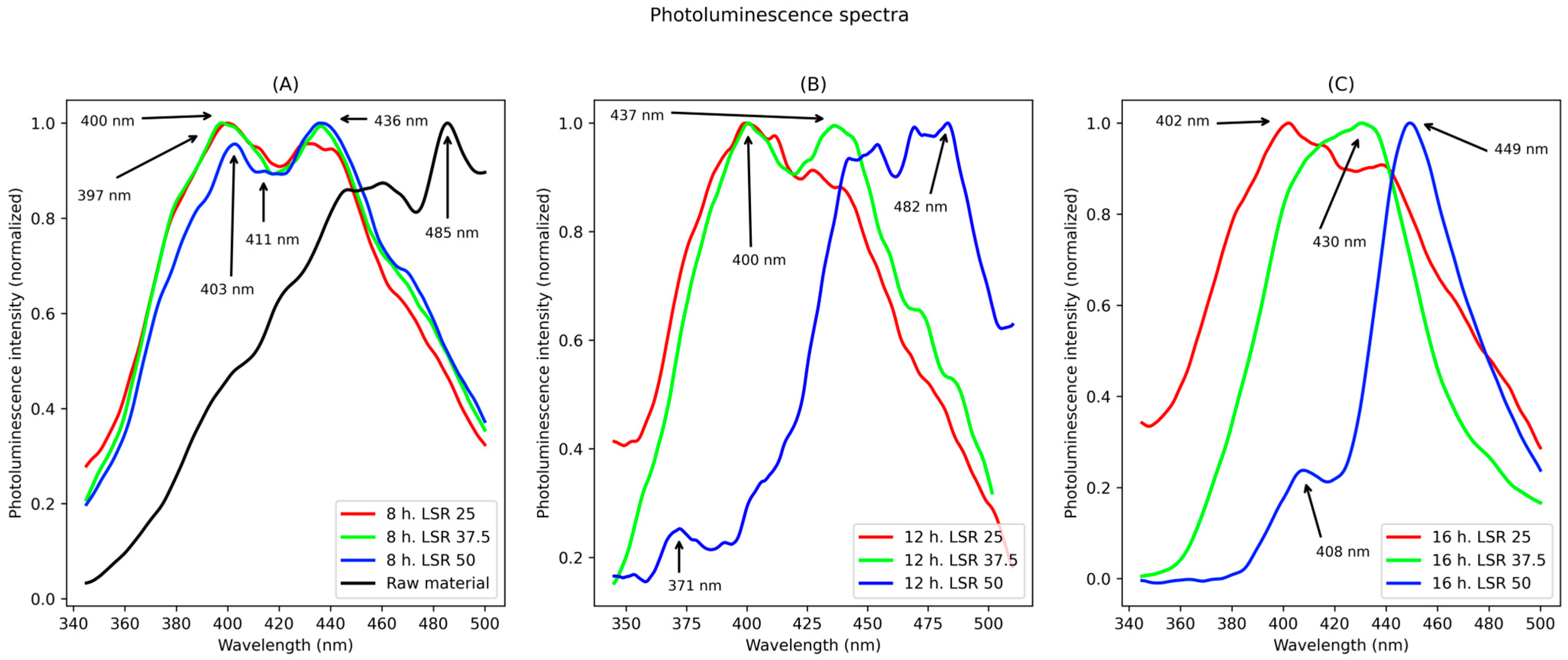
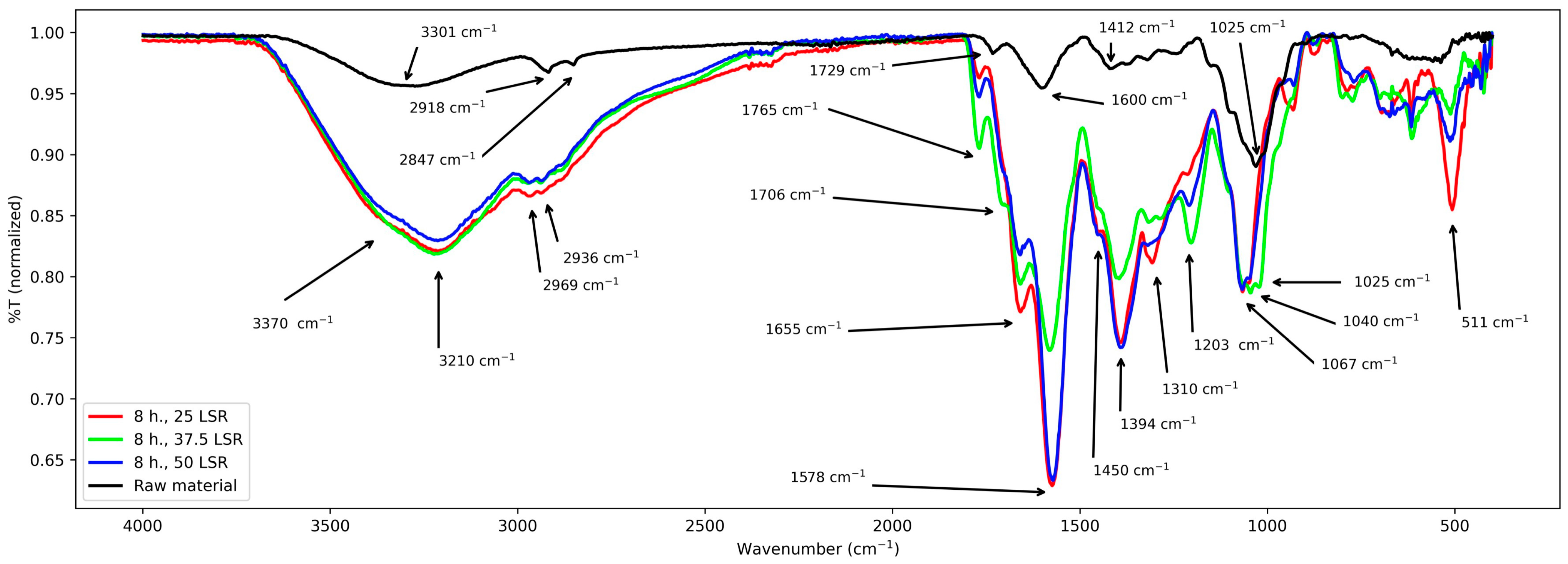
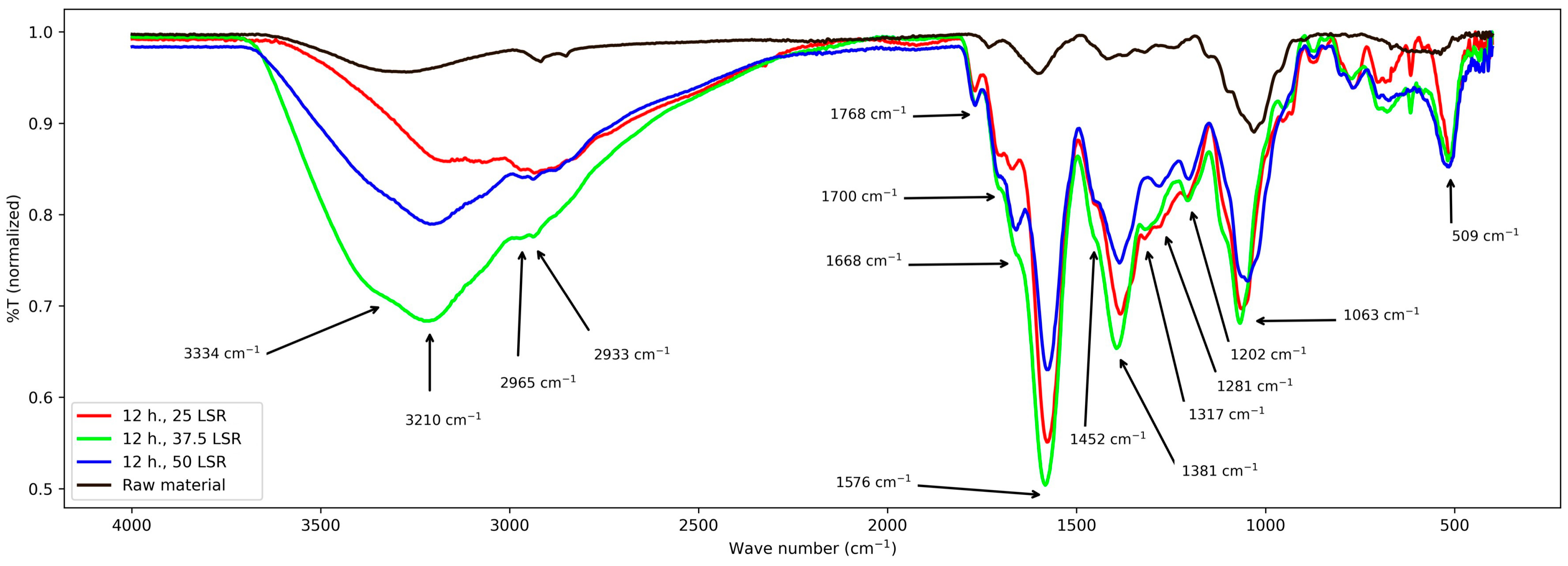
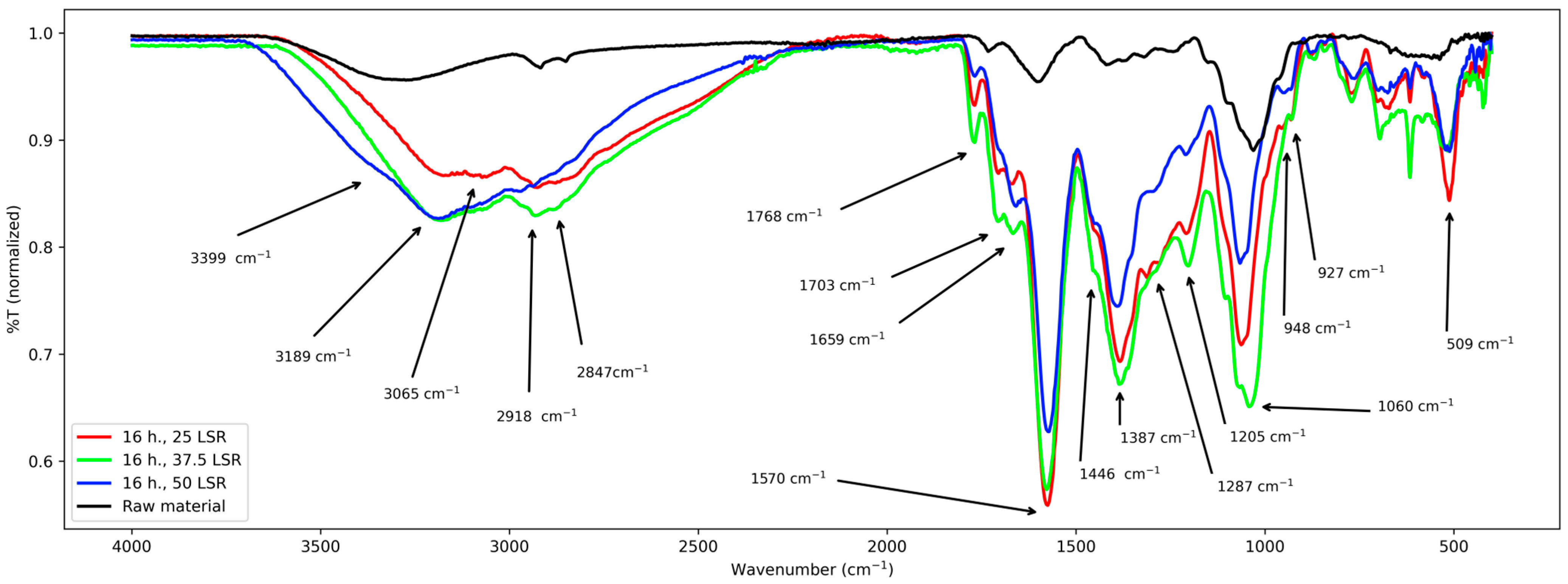
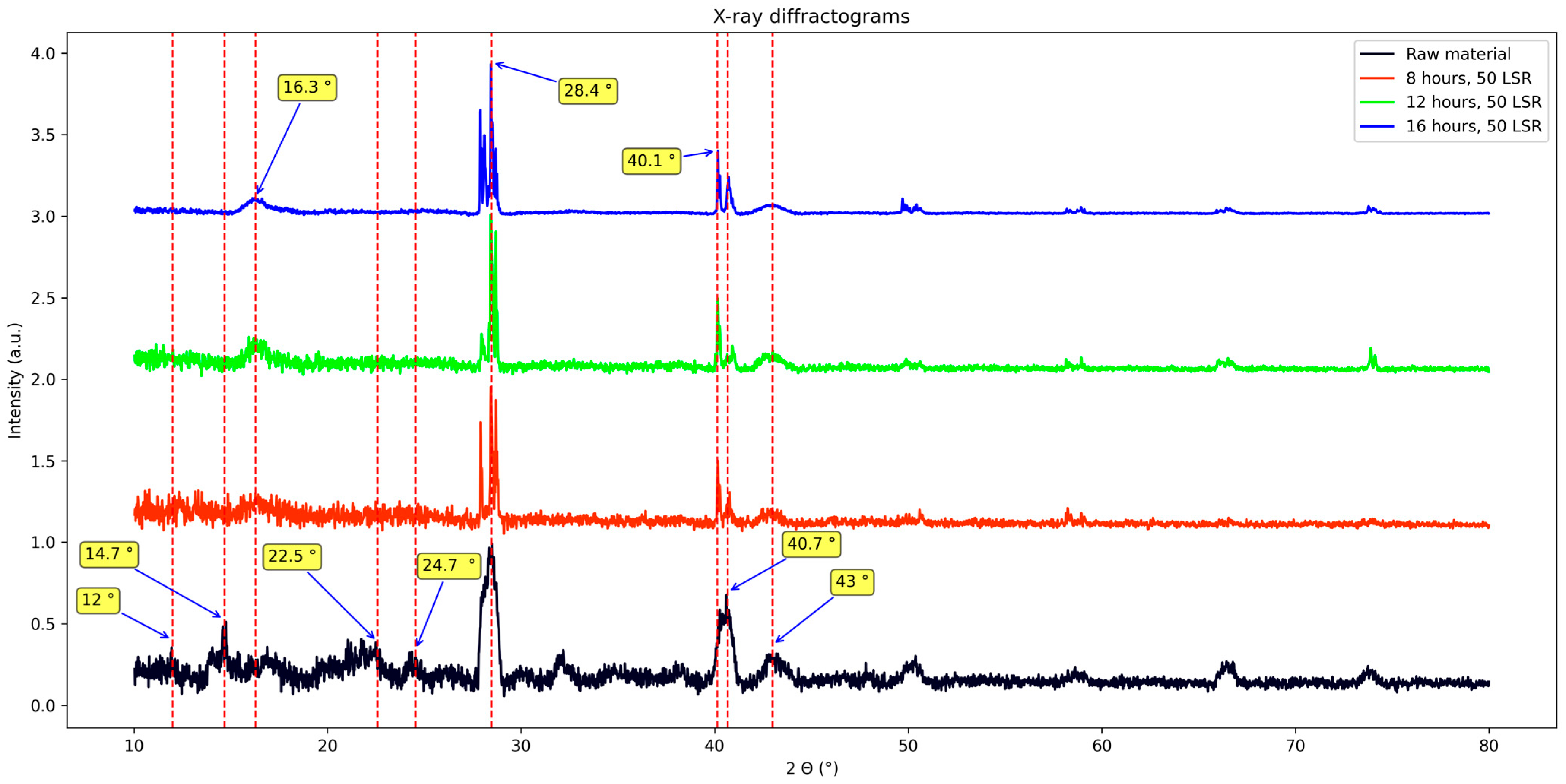
Disclaimer/Publisher’s Note: The statements, opinions and data contained in all publications are solely those of the individual author(s) and contributor(s) and not of MDPI and/or the editor(s). MDPI and/or the editor(s) disclaim responsibility for any injury to people or property resulting from any ideas, methods, instructions or products referred to in the content. |
© 2025 by the authors. Licensee MDPI, Basel, Switzerland. This article is an open access article distributed under the terms and conditions of the Creative Commons Attribution (CC BY) license (https://creativecommons.org/licenses/by/4.0/).
Share and Cite
Ibarra-García, V.G.; Téllez-Jurado, A.; Azpeitia-Vera, J.A.; Vázquez-García, R.A.; Castano, V.M. Photoluminescence Modulation of Fluorophores Extracted from Water Hyacinth (Eichhornia crassipes) Biomass via a Hydrothermal Process. Colorants 2025, 4, 32. https://doi.org/10.3390/colorants4040032
Ibarra-García VG, Téllez-Jurado A, Azpeitia-Vera JA, Vázquez-García RA, Castano VM. Photoluminescence Modulation of Fluorophores Extracted from Water Hyacinth (Eichhornia crassipes) Biomass via a Hydrothermal Process. Colorants. 2025; 4(4):32. https://doi.org/10.3390/colorants4040032
Chicago/Turabian StyleIbarra-García, Víctor Gerardo, Alejandro Téllez-Jurado, Juan Antonio Azpeitia-Vera, Rosa Angeles Vázquez-García, and Victor M. Castano. 2025. "Photoluminescence Modulation of Fluorophores Extracted from Water Hyacinth (Eichhornia crassipes) Biomass via a Hydrothermal Process" Colorants 4, no. 4: 32. https://doi.org/10.3390/colorants4040032
APA StyleIbarra-García, V. G., Téllez-Jurado, A., Azpeitia-Vera, J. A., Vázquez-García, R. A., & Castano, V. M. (2025). Photoluminescence Modulation of Fluorophores Extracted from Water Hyacinth (Eichhornia crassipes) Biomass via a Hydrothermal Process. Colorants, 4(4), 32. https://doi.org/10.3390/colorants4040032






